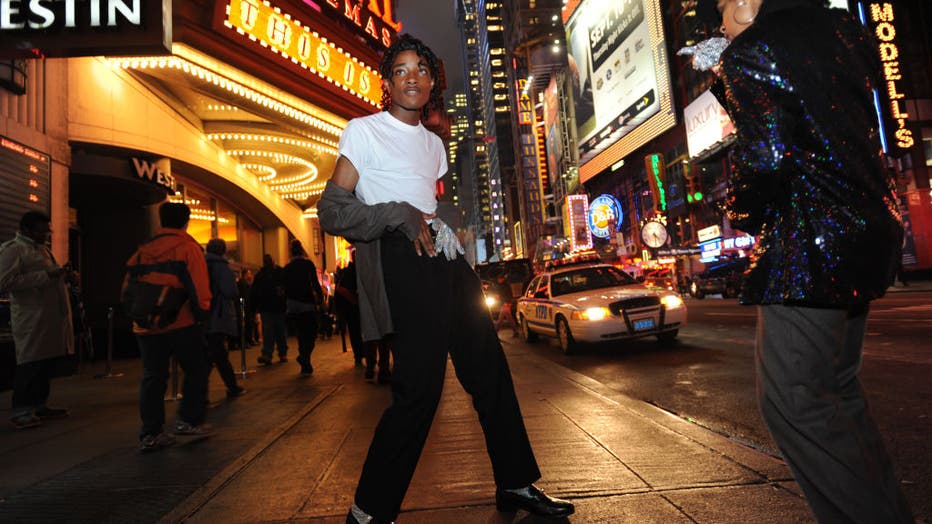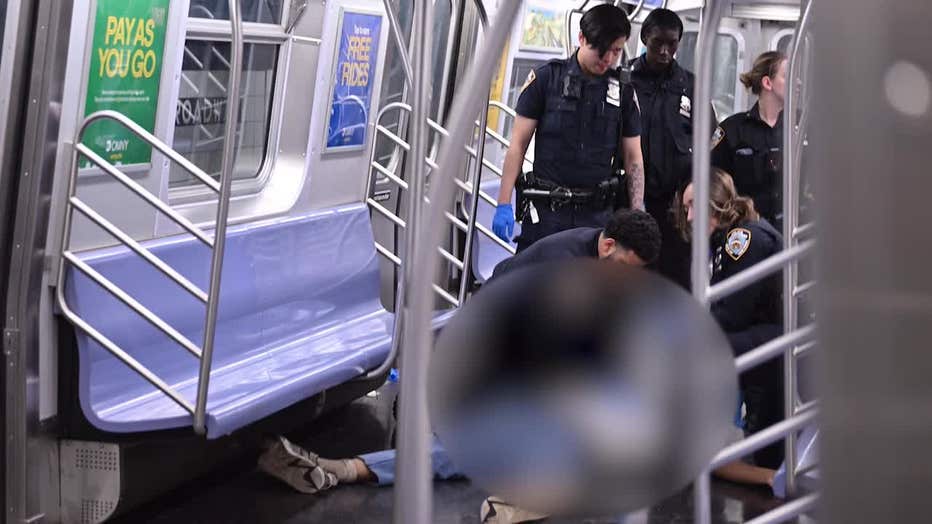Jordan Neely: What we know about his subway chokehold death

Jordan Neely, Daniel Penny attorneys respond to arrest
Attorneys for Jordan Neely and Daniel Penny spoke Friday after the 24-year-old ex-Marine turned himself in for a charge of second-degree manslaughter in connection with Neely's subway chokehold death. FOX 5 NY?s Linda Schmidt has more on what?s next.
NEW YORK CITY - The choking death of Jordan Neely at the hands of a 24-year-old Marine veteran on the NYC subway has made national headlines.
Here's what we know about the story:
Who was Jordan Neely?
Neely had earned money imitating Michael Jackson in the past, but was homeless at times.
Street performers who knew Neely described him as a kind and gifted impressionist who sank into a depression as a result of his mother’s 2007 death. According to news accounts at the time, Christie Neely was strangled.

Jordan Neely is pictured before going to see the Michael Jackson movie outside the Regal Cinemas in Times Square in 2009. (Andrew Savulich/New York Daily News/Tribune News Service via Getty Images)
Neely, who was 14 when she died, testified against his mother’s boyfriend at the murder trial.
"He was a good kid. He just had a rough life," said Melyssa Votta a friend who attended high school with Neely at Washington Irving High.
Tari Tudesco, a backup dancer in the Michael Jackson tribute act "Michael’s Mirror," said many in the community had grown worried about Neely’s absence in recent years and had begun searching for him, unsuccessfully.
"We were in shock to find now that he was living homeless," she said. "We feel terrible."
Neely did have a criminal record with a history of 44 prior arrests – many of them subway related, including disorderly, conduct, assault, and fare evasion.
Who is Daniel Penny, the man in the chokehold video?
Daniel Penny, the 24-year-old Marine veteran at the center of Jordan Neely's choking death, turned himself in to police to face a criminal charge over the incident.
RELATED: Jordan Neely: Daniel Penny turns himself in to face manslaughter charge
Police originally questioned Penny, whom the video showed holding Neely in a headlock for at least three minutes, perhaps longer, but released him without charges.

NYC chokehold death: Calls for justice after death of Jordan Neely
Some are calling the choking death of a man at the hands of another New York subway rider a criminal act. Others justify the killing as defense against dangerous disorder. Manhattan prosecutors promised a ?rigorous? investigation into whether to bring charges in the death of Jordan Neely, a Black man who was tackled by fellow passengers and put in a fatal chokehold by a white Marine veteran.
Attorneys for the Marine veteran released a statement May 5. It reads:
"We would first like to express, on behalf of Daniel Penny, our condolences to those close to Mr. Neely. Mr. Neely had a documented history of violent and erratic behavior, the apparent result of ongoing and untreated mental illness. When Mr. Neely began aggressively threatening Daniel Penny and the other passengers, Daniel, with the help of others, acted to protect themselves, until help arrived. Daniel never intended to harm Mr. Neely and could not have foreseen his untimely death.
"For too long, those suffering from mental illness have been treated with indifference. We hope that out of this awful tragedy will come a new commitment by our elected officials to address the mental health crisis on our streets and subways."
How is Neely's family responding?
In a statement, Neely family attorneys Donte Mills and Lennon Edwards said:
"Daniel Penny’s press release is not an apology nor an expression of regret. It is a character assassination, and a clear example of why he believed he was entitled to take Jordan‘s life. In the first paragraph he talks about how ‘good’ he is and the next paragraph he talks about how ‘bad’ Jordan was in an effort to convince us Jordan’s life was ‘worthless.’ The truth is, he knew nothing about Jordans history when he intentionally wrapped his arms around Jordan‘s neck, and squeezed and kept squeezing."
"In the last paragraph, Daniel Penny suggests that the general public has shown ‘indifference’ for people like Jordan, but that term is more appropriately used to describe himself. It is clear he is the one who acted with indifference, both at the time he killed Jordan and now in his first public message. He never attempted to help him at all. In short, his actions on the train, and now his words, show why he needs to be in prison."
Protests over Jordan Neely's death
The NYPD is looking for several people accused of storming city subway tracks over the weekend as a call for justice in the chokehold death.

Jordan Neely: NYPD seeks 6 protesters accused of storming NYC subway tracks
The NYPD is looking for several people accused of storming subway tracks over the weekend as a call for justice in the chokehold death of Jordan Neely. FOX 5 NY's Briella Tomassetti has the story.
Police arrested 13 people Saturday night for fighting with officers, and are still seeking six others in connection with the protest that unfolded inside the Lexington Avenue/63rd Street subway station on the Upper East Side.
Demonstrators jumped onto the tracks, forcing an inbound ‘Q’ train with hundreds of passengers on board to come to an abrupt halt as it pulled up to the platform.
A Monday protest demanding justice for Jordan Neely ended in at least 11 arrests.

Jordan Neely: NYPD arrests at least 11 protesters, Molotov cocktail found
It was another night of unrest on New York City streets, as a Monday protest demanding justice for Jordan Neely ended in several arrests. FOX 5 NY's Briella Tomassetti has the story.
Demonstrations started out peacefully, as protesters returned to the Broadway-Lafayette station where the 30-year-old Neely lost his life, demanding justice and accountability.
But the situation quickly escalated, as the crowd spilled out into oncoming traffic and refused to stop, using a microphone system, even after being ordered by police to do so.
Protesters yet again clashed with police, resulting in several arrests.
How did Jordan Neely die?
The death of Neely has been ruled a homicide by the New York City Medical Examiner's Office.
MORE: Homeless man's death ruled a homicide
According to the medical examiner, Neely died as a result of compression of his neck caused by the chokehold.

Outrage grows after
The New York City Medical Examiner's Office has declared the death of Jordan Neely, the homeless man who was placed into a chokehold by other passengers on a subway train this week, a homicide.
Video showed riders attempting to subdue Neely. Lying on the floor of the subway car, the Marine veteran had Neely in a sleeper hold from behind while another man tried to immobilize his arms.
A separate video showed EMTs attempting to revive him.
Has anyone been charged in Jordan Neely's death?
Penny faces a charge of second-degree manslaughter, which could carry a jail term of up to 15 years.
Steven Raiser, the attorney representing Penny, shared a statement, saying, in part, "We are confident that once all the facts and circumstances surrounding this tragic incident are brought to bear, Mr. Penny will be fully absolved of any wrongdoing."
MORE: Calls for criminal charges after death of Jordan Neely
It was not clear why passengers moved to restrain Neely.

Video shows EMTs trying to revive Neely.
One witness, a freelance journalist who was on the train and recorded Neely becoming unconscious as he was restrained, said that while Neely was acting aggressively and threw his jacket, he hadn't attacked anyone.
Police have asked other witnesses to come forward and sought additional photos and videos that might help investigators understand what transpired during the fatal confrontation or what triggered it.
What is the history of chokeholds in NYC?
Marine recruits are routinely taught about executing and defending against chokeholds, which can render someone unconscious in as few as eight seconds, according to a military manual revised in 2020.

Video shows the marine veteran, with Neely in a sleeper hold from behind, while another man tries to immobilize his arms. (Storyful)
The lethal risks of chokeholds led New York City to ban police from using them. An officer was fired for using a chokehold on Eric Garner, a Black New Yorker whose dying words "I can't breathe" became a chant in protests against racial injustice.
A U.S. Department of Justice website called chokeholds "inherently dangerous" and said that they have "too often led to tragedy."
How are elected officials reacting to Jordan Neely's death?
In the absence of video showing what happened before the chokehold, many were reserving judgment.
MORE: Adams responds amid outrage over homeless man's death
Among them was Mayor Eric Adams, who initially said there were "many layers" to the incident. He rejected criticism that he has not expressed enough outrage over Neely's death, unlike other officials who have called for a quick arrest.

NYC subway chokehold: Mayor Adams responds amid outrage over homeless man's death
"Let's let the DA conduct his investigation with law enforcement officials." That's the message from Mayor Eric Adams following the death of a homeless man who was placed in a chokehold by a subway rider after allegedly acting aggressively toward other passengers. FOX 5 NY's Briella Tomassetti has the story.
"All the other electeds, they have a role to play, and I have a role to play," Adams said. "The police is doing their investigation and the district attorney is doing his investigation, and I respect the process."
In an address about a week later, Adams said the death of Neely was "a tragedy that never should have happened" and pledged to do more to help people experiencing mental health crises.
"My heart goes out to Jordan’s family, who is suffering great pain and uncertainty about the circumstances of his death," Adams said.

Leaders speak out about the death of Jordan Neely
Mayor Adams spoke out on the chokehold death of Jordan Neely. FOX 5 NY's Arthur Chi'en has his response.
Gov. Kathy Hochul called the video-recorded encounter "wrong" and "horrific to view," adding Neely's "family deserves justice." But the governor said she was watching how the matter unfolds.
"No one has the right to take the life of another person, and in this circumstance, I have said all along and have stood firm in our commitment to helping people with mental health challenges," Hochul said.
She said sometimes people are loud and emotional in public, but it was "very clear" Neely was not going to harm others and the video showed a "very extreme response."
___
Associated Press researcher Rhonda Shafner in New York and reporters Lolita Baldor in Washington and Maysoon Kahn in Albany, New York, contributed.

